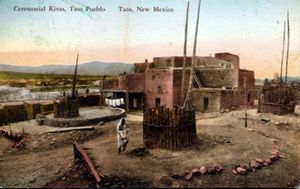Juan Mirabal facts for kids
Quick facts for kids
Juan Mirabal
|
|
|---|---|
| Born |
Juan Mirabal, Tapaiu or Red Dancer
1903 |
| Died | 1981 (aged 77–78) |
| Nationality | Taos Pueblo |
| Education | Marjorie Eaton, American modernist artist and Louis Leon Ribak, a Taos modernist painter |
| Known for | Realistic depiction of pueblo life: oil paintings and murals |
| Movement | Modern art and Cubism |
Juan Mirabal (1903 – 1981), also known as "Tapaiu" or Red Dancer, was a talented artist from Taos Pueblo, New Mexico. He was known for painting realistic pictures of his community and its traditions.
Three Taos Pueblo Painters
Juan Mirabal was one of three important artists from Taos Pueblo. The other two were Albert Looking Elk and Albert Lujan. These three men are often called the "Three Taos Pueblo" painters.
As the Taos art colony grew, these artists learned to paint with oils and watercolors. They created art that showed their community and culture from a Native American point of view. Their artwork was featured in a special show called "Three Pueblo Painters." This show was held at the Harwood Museum of Art in Taos, New Mexico in 2003.
Juan Mirabal sometimes posed for other artists in Taos. He was a realist painter, meaning he painted things as they looked in real life. He also painted large pictures called murals. His main inspiration came from the Taos Pueblo, its people, and the beautiful land around it. Of the three painters, Juan Mirabal had the longest career.
About Taos Pueblo

Taos Pueblo is located in a valley near the Rio Grande river in New Mexico. It is the northernmost of the pueblo communities. The Taos tribe has lived there for almost a thousand years. Experts believe the pueblo was built between the years 1000 and 1450 CE. It is considered the oldest community in the United States where people have lived continuously.
The buildings at Taos Pueblo can be as tall as five stories. They are made up of many individual homes that share walls. More than 1,900 people are part of the Taos pueblo community. Some live in modern homes nearby and move to the pueblo in colder weather. About 150 people live at the pueblo all year.
In 1992, Taos Pueblo became a UNESCO World Heritage Site. This means it is a very important historical and cultural landmark in the world. Other famous World Heritage Sites include the Taj Mahal in India and the Great Pyramids in Egypt.
For hundreds of years, Pueblo artists have painted using natural materials. They used tempera, clay, and earth colors on textiles, walls, pottery, and animal hides. Juan Mirabal, Albert Looking Elk, and Albert Lujan learned to use European painting materials and techniques.
Starting His Art Career
Juan Mirabal began painting with the help of Marjorie Eaton. She was an American artist. Later, after serving in the U.S. Army during World War II, he studied art in the late 1940s. His teacher was Louis Leon Ribak, a modernist painter from Taos. Ribak ran an art school after the war ended.
Unlike some other well-known painters from Taos Pueblo, Mirabal was a quiet artist. He did not have a shop in the pueblo. However, many people visited him and bought his paintings directly.
Professional Artworks
Mirabal was unique because he painted realistic scenes of pueblo ceremonial dances. His art was influenced by modern art and by a style called Cubism in the 1930s. Marjorie Eaton, who taught him, was trained in modern art in Europe. She came to Taos in the late 1920s. She became good friends with Juan, and he was her model and student. She taught him the basics of modern art before he studied with Louis Leon Ribak.
Juan Mirabal painted many murals. A large mural he created can still be seen in a home that is now the Adobe & Pines Inn Bed & Breakfast. Mirabal is known for bringing a lot of life and energy to his paintings. He used vibrant colors and interesting compositions.
Juan Mirabal's painting called Taos Pueblo inspired this poem by Enrique Pinedo, a student:
- Taos Pueblo
- The ground was rough under my feet.
- The man was getting some wood.
- The mountain looks like black paper.
- The people look like Eskimos.
- I smell honey in the village.
- It sounds like drums beating and singing.

